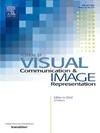3D surface reconstruction with enhanced high-frequency details
IF 3.1
4区 计算机科学
Q2 COMPUTER SCIENCE, INFORMATION SYSTEMS
Journal of Visual Communication and Image Representation
Pub Date : 2025-05-17
DOI:10.1016/j.jvcir.2025.104475
引用次数: 0
Abstract
Neural implicit 3D reconstruction can reproduce shapes without the need for 3D supervision, making it a significant advancement in computer vision and graphics. This technique leverages volume rendering methods and neural implicit representations to learn and reconstruct 3D scenes directly from 2D images, enabling the generation of complex geometries and detailed structures with minimal data. The field has gained significant traction in recent years, due to advancements in deep learning, 3D vision, and rendering techniques that allow for more efficient and realistic reconstructions. Current neural surface reconstruction methods tend to randomly sample the entire image, making it difficult to learn high-frequency details on the surface, and thus the reconstruction results tend to be too smooth. We designed a method, termed FreNeuS (Frequency-guided Neural Surface Reconstruction), which leverages high-frequency information to address the problem of insufficient surface detail. Specifically, FreNeuS uses pixel gradient changes to easily acquire high-frequency regions in an image and uses the obtained high-frequency information to guide surface detail reconstruction. High-frequency information is first used to guide the dynamic sampling of rays, applying different sampling strategies according to variations in high-frequency regions. To further enhance the focus on surface details, we have designed a high-frequency weighting method that constrains the representation of high-frequency details during the reconstruction process. Compared to the baseline method, Neus, our approach reduces the reconstruction error by 13% on the DTU dataset. Additionally, on the NeRF-synthetic dataset, our method demonstrates a significant advantage in visualization, producing clearer texture details. In addition, our method is more applicable and can be generalized to any reconstruction method based on NeuS.
增强高频细节的3D表面重建
神经隐式三维重建可以在不需要三维监督的情况下再现形状,使其成为计算机视觉和图形学的重大进步。该技术利用体绘制方法和神经隐式表示直接从2D图像中学习和重建3D场景,从而能够以最少的数据生成复杂的几何形状和详细的结构。近年来,由于深度学习、3D视觉和渲染技术的进步,该领域获得了显著的发展,这些技术可以实现更高效、更逼真的重建。目前的神经表面重建方法往往是对整个图像进行随机采样,很难学习到表面上的高频细节,因此重建结果往往过于光滑。我们设计了一种称为FreNeuS(频率引导神经表面重建)的方法,该方法利用高频信息来解决表面细节不足的问题。具体来说,FreNeuS利用像素梯度变化轻松获取图像中的高频区域,并利用获得的高频信息指导表面细节重建。首先利用高频信息指导射线的动态采样,根据高频区域的变化采用不同的采样策略。为了进一步增强对表面细节的关注,我们设计了一种高频加权方法,该方法在重建过程中限制了高频细节的表示。与基线方法相比,我们的方法在DTU数据集上的重建误差降低了13%。此外,在nerf合成数据集上,我们的方法在可视化方面显示出显着的优势,可以产生更清晰的纹理细节。此外,我们的方法更具适用性,可以推广到任何基于news的重建方法。
本文章由计算机程序翻译,如有差异,请以英文原文为准。
求助全文
约1分钟内获得全文
求助全文
来源期刊

Journal of Visual Communication and Image Representation
工程技术-计算机:软件工程
CiteScore
5.40
自引率
11.50%
发文量
188
审稿时长
9.9 months
期刊介绍:
The Journal of Visual Communication and Image Representation publishes papers on state-of-the-art visual communication and image representation, with emphasis on novel technologies and theoretical work in this multidisciplinary area of pure and applied research. The field of visual communication and image representation is considered in its broadest sense and covers both digital and analog aspects as well as processing and communication in biological visual systems.
 求助内容:
求助内容: 应助结果提醒方式:
应助结果提醒方式:


